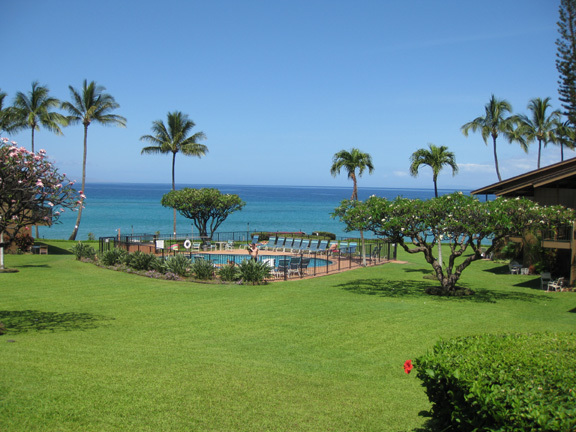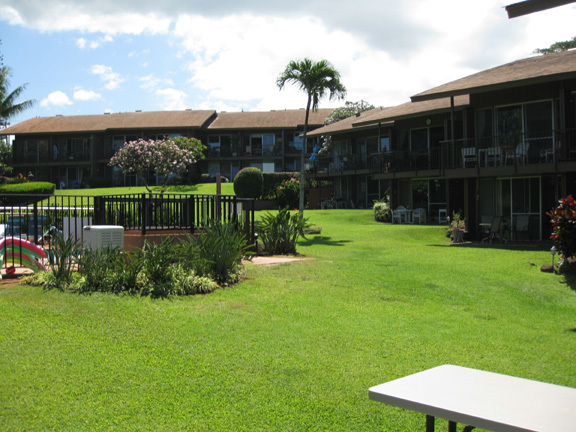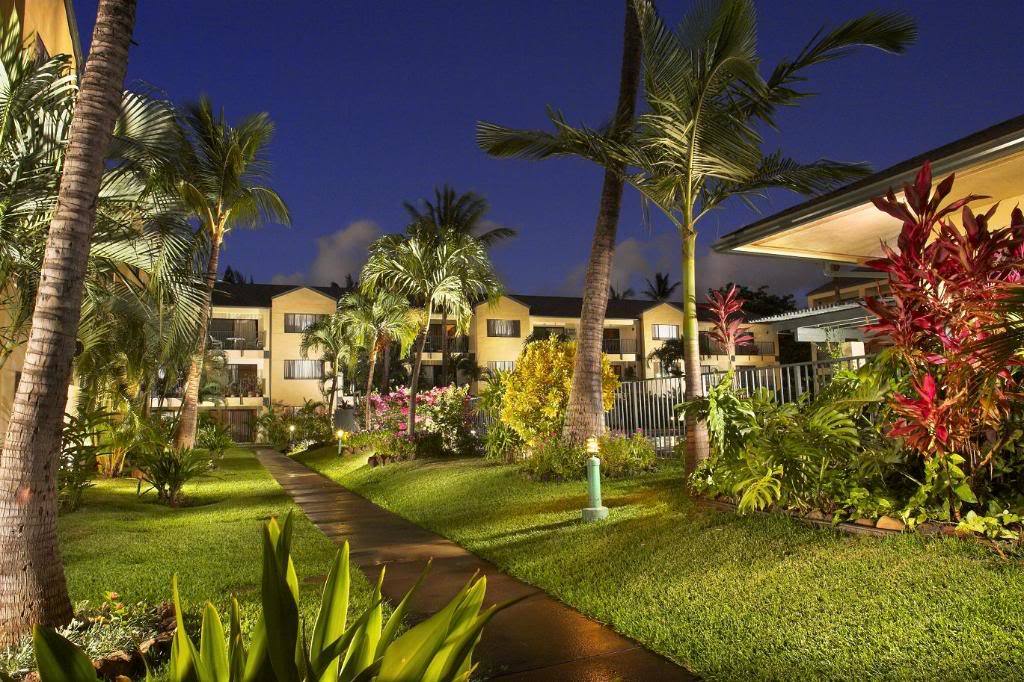- This topic has 1 reply, 15 voices, and was last updated 14 years, 6 months ago by
 Louis Wynne.
Louis Wynne.
-
AuthorPosts
-
April 28, 2011 at 10:10 pm #163216
 mauiBobParticipant
mauiBobParticipantJordan, Unless your regional area has a completely different “bend-a-board” product; I have no knowledge of the kind of plastic edging you are referring to. From what I know, even the so-called firmer “boards” bend the same way…maybe you and I are just not familiar with all of the products available in the market.
FYI you and Dennis: I stated this is my condo unit. It existed long before I started living here, so I do not know the landscape architect or contractor who did the installation. In my 12 years of landscape experience, you never know what type of conditions that affected the design. Sometimes, the LA makes a design and years later, the owner makes changes or additions without the original LA’s input.
Here is a panoramic view. No close ups. The edging isn’t even noticeable unless you walk right up to it.
April 28, 2011 at 10:19 pm #163215 mauiBobParticipant
mauiBobParticipantDennis, Read my comments below. Never assume you know the entire story of a design by just looking at its current condition. Maybe the condo home associations board wanted to install it “after” the original design was made 20 years ago to keep the lava rocks from being easily swept onto the sidewalk. Who knows?! Why would someone buy a BMW when a Chevy also gets you from point A to B? If they have the money to do so, they can do whatever the heck they want.
April 28, 2011 at 11:01 pm #163214 Andrew Garulay, RLAParticipant
Andrew Garulay, RLAParticipantAnother problem with a lot of edging products is that it expands in heat and then lifts and twists. We used to use Valley View and Oly-ola when I was working in Idaho while in school. People wanted it (I hate it). When we istalled it in the heat of the summer it would shrink and expose the connectors for the winter. When we installed it in cool weather it would lift and twist in August.
It is extremely rare to see it used in New England – very traditional in landscape materials and other design aesthetics.
April 29, 2011 at 3:26 am #163213 Heather SmithParticipant
Heather SmithParticipantIf it is what I think you are talking about Andrew…yes, it is hideous and everywhere here. Kind of like the black plastic people lay on slopes that have bark sliding off of it.
April 29, 2011 at 4:21 am #163212 Heather SmithParticipant
Heather SmithParticipantAlso, something else to consider with playgrounds and any sort of edging is that kids will tear it up. If you use the sort of edging that Andrew is talking about…it could be a disaster.
April 29, 2011 at 4:49 pm #163211Mike G
ParticipantYes it has. I don’t know how many or if any court cases involved landscape edging. But many cities and corporations budget to cover this type of litigation. Maybe lawyers are to blame and maybe so are landscape designers for designing ‘play equipment’ in the first place. In many circumstances a pile of rocks, a couple of old pallets, and a few easy to climb trees can make for a more engaging, fulfilling, and spontaneous play atmosphere then standard playground equipment item number 123. Is this a flaw in product or site design or even a flaw in our entire civilization? I don’t know, perhaps a suitable topic for a landscape theory course in your university curriculum.
It is what it is, kids get hurt on playgrounds all the time anyway… Back to the edging. Whenever that stuff pops up out of the ground (and it does in frost prone areas >4″) it is a tripping hazard and can also get eaten up by lawnmowers or string trimmers. Then it looks unkempt and tacky. If your client is ok with that then ok (repair / replace on an as needed basis). I think this is really a small minor problem but also a very common one.
April 30, 2011 at 8:50 pm #163210Deborah Christman
ParticipantI used Permaloc aluminum edging 2 yrs ago to keep DG in my path and the dirt and mulch from my berms out. I called asalesman at Permaloc and he was very helpful specifying what I needed. They then sent CAD dwgs to show how it needs to be installed. I was very careful to put in geotextile, then gravel then another layer of geotextile before the DG.
So today that path still looks as good as the first day. Permaloc bends nicely for a sepentine path, and the connections are subtle. Very clean look.
April 30, 2011 at 10:02 pm #163209 Jason T. RadiceParticipant
Jason T. RadiceParticipantWhy not a flush concrete curb? Permanent, nice mowing egde, and very flexible (to install).
May 1, 2011 at 3:13 am #163208Nic Wurzbacher
Participanttry this I will send you some other links but it is a similar material.http://www.frankwall.com/products/flexi.html
May 2, 2011 at 5:51 pm #163207 Elizabeth RentonParticipant
Elizabeth RentonParticipant[Like!!!]
I hate the raised playground equipment surrounded by a moat of black plastic timber edging. And the plastic edging buried in-ground also tends to pop up/out, get run over by lawn mowers, and otherwise go awry. I think a flush poured-in-place concrete curb is the way to go. Excavate 9-12″ for the wood fiber fill so the whole system sits at-grade. No tripping hazard, not a lot of maintenance, although the wood fiber will still tend to migrate out. But that’s to be expected anyway.
May 2, 2011 at 5:56 pm #163206 Elizabeth RentonParticipant
Elizabeth RentonParticipant[like] [like] [like]
probably a discussion for a whole different thread but one of my pet peeves is when landscape architects and architects slap down a piece of plastic play equipment and call it a playground. If you know ANYTHING about child development you know that those plastic behemoths are not the most engaging play environments. They only encourage physical activity. Children engage in play in a variety of ways, incorporating different cognitive, emotional, and social skills. They need creative, open-ended opportunities for play, which the plastic structures are not good at providing. Think back to the old analogy about the small child at a birthday party, who spends about 2 minutes playing with the toy that came in the box, and about an hour playing with the box instead, pretending it was a spacecraft or firetruck or something else. Landscape architects need to do a better job of creating appropriate play environments that promote creative free play!
May 2, 2011 at 9:53 pm #163205 mauiBobParticipant
mauiBobParticipantElizabeth, What you’re talking about and the original discussion question are day and night. If you are doing a private estate with a playground, maybe your idea is ideal, but most other clients want those plastic structures which allows kids physical play. Better than PlayStation for 4 hours a day. Sometimes you have to be practical.
May 2, 2011 at 10:02 pm #163204 mauiBobParticipant
mauiBobParticipantYou and Andrew simply have different experiences with edging in general than myself. With all the fun, colorful play equipment around, why would any kid play with a plastic edging? There’s nothing beyond the edging to play in. Some clients really do want it and if its done correctly, you don’t even notice it.
May 2, 2011 at 10:06 pm #163203 mauiBobParticipant
mauiBobParticipantI have NEVER seen the plastic edging type surround an entire play equipment. If this edging is used, then its only found in front of shrubs in the perimeter.
May 2, 2011 at 10:10 pm #163202 mauiBobParticipant
mauiBobParticipant-
Mike, I love it when people still in school start to tell RLAs about “real world” design and details! I guess those fantasy projects from school adequately prepare students for the real thing. The topic was edging and not the actual play equipment. You are off in a tangent. Did you even see the photos I posted? And what kid is going to trip on a rounded, 1/2″ edging set around the perimeter. A typical parking lot is more dangerous.
This is what I mean by fantasy projects in school: so you are going to tell your client (the one paying your bills) that instead of the play equipment from GameTime, you’ll suggest rocks, old pallets and climb trees…right? That might work with your professor and classmates, but it won’t fly outside the cozy, comfort of the University setting.
-
-
AuthorPosts
- You must be logged in to reply to this topic.





